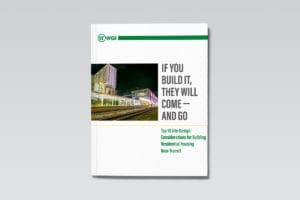
If You Build It, They Will Come — And Go
Don’t let your next TOD project flop. WGI has the top 10 site-design considerations for building residential housing near transit and the expert team to ensure your TOD project is a success!
Learn from award-winning professionals — explore our whitepapers, blogs, and the latest industry updates.
Join our dynamic organization of engineers, land surveyors, landscape architects, environmental scientists, and architects!
Talk to a market leader today! We’ll answer any questions you have about our professional services.

There’s an updated version of this study available! Click here to download the 2021 Parking Structure Cost Outlook today!
For many years, WGI’s Parking Solutions division (formerly Carl Walker, Inc.) has prepared this annual statistical analysis of parking structure construction costs and new parking structure market forecast. WGI is an ENR Top 500 engineering and consulting firm specializing in Civil Engineering, Environmental Consulting, Geospatial and Land Surveying, Land Design Services, MEP Engineering, Parking Solutions, Smart and Connected Communities, Structural Engineering, Subsurface Utility Engineering (SUE), Traffic Engineering, Transportation Engineering, Transportation Design- Build, Water Resources, and Architecture. The Parking Solutions division of WGI specializes in parking structure design; structural engineering; parking studies; parking operations consulting; and restoration of parking structures, plazas, facades, and other buildings, just as Carl Walker did for 33 years.
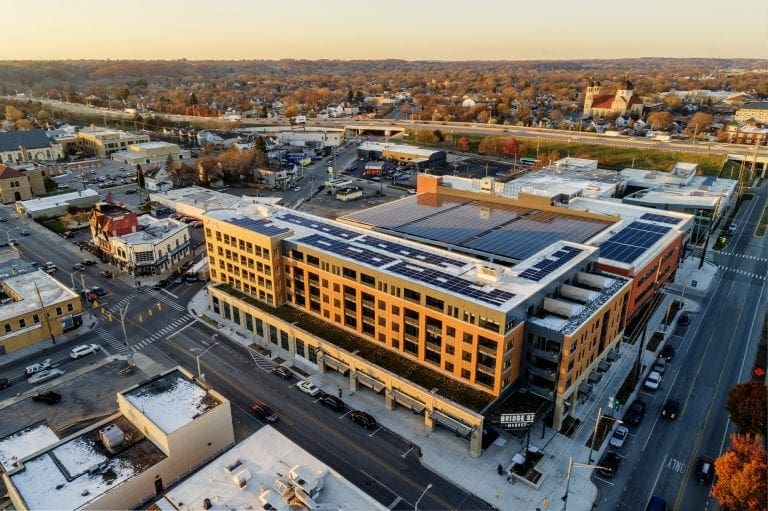
We maintain a database of completed parking structure projects, developing a methodology to analyze the historical cost information that assists our clients and the industry. Our construction cost database contains hundreds of completed parking structure projects of varying size, scope, and geographic location. For this forecast, we only omit the cost of parking structures completely or significantly below grade, since the cost of such structures is much higher. The cost data is assigned factors based on the time of bidding and parking structure location. The time factor is based on the Building Cost Index (BCI), published by Engineering News- Record (ENR). The location factor is taken from the yearly edition of the RS Means Building Construction Cost Data. Applying these two factors to actual construction cost data adjusts the cost to a current national basis; from that we determine the national median. The national median can then be re-adjusted to reflect a median construction cost in almost every city in America.
As of March 2019, our statistical data indicates that the median construction cost for a new parking structure is $21,500 per space and $64.77 per square foot, increasing 5.1% from March 2018 when the median cost was $20,450 per space based on our historical database. The table below lists the 2019 median parking structure construction costs in various U.S. cities with the lowest in Miami, the highest in New York City, and Portland, OR the closest to the national average of 100.0.
There’s an updated version of this study available! Click here to download the 2021 Parking Structure Cost Outlook today!
It should be noted that the construction cost data does not include costs for items such as land acquisition, architectural and engineering fees, environmental evaluations, materials testing, special inspections, geotechnical borings and recommendations, financing, owner administrative and legal, or other project soft costs. Soft costs are typically about 15% to 20% of construction costs, but can be higher for owners who allocate their internal costs directly to the project.
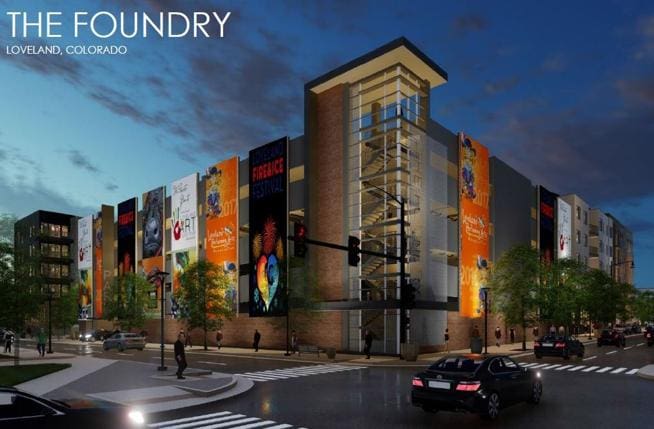
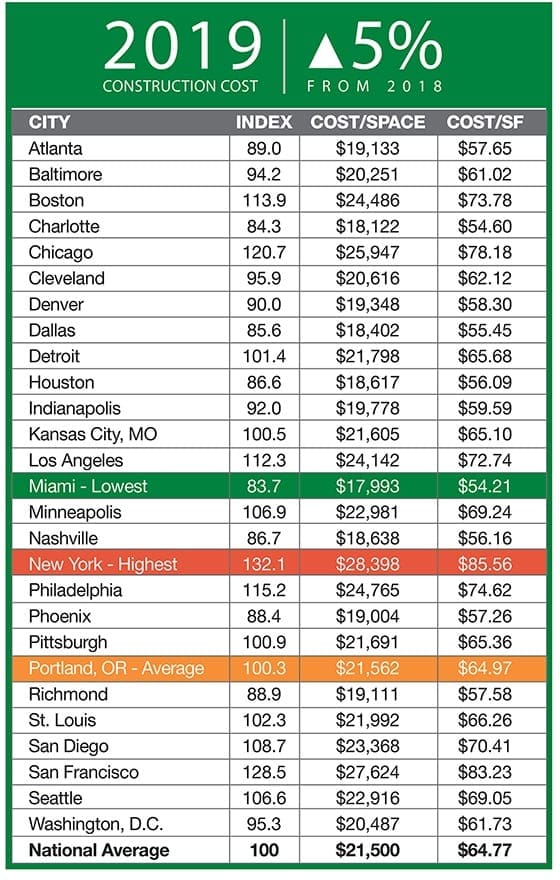
For comparison, a median cost parking structure today typically includes such features as:
Today’s parking structure construction cost would be higher than the median if it includes such enhanced features as:
“The construction market is enjoying a decade of steady growth, and most (construction firm) senior executives don’t see an immediate cause for concern.”1 Likewise, construction of mixed-use and stand-alone parking structures should see a continuation of the strong market as institutional sector construction spending (e.g., city governments, higher education, and healthcare) is predicted to grow 4.8% during 2019 and 2.9% during 2020. Growth in the commercial, office, and retail sectors are predicted to be about 3.5% during 2019, but only 0.6% for 2020 as the market is predicted to slow.
Over the past few years, there was concern that projected economic growth would lead to construction cost escalation and longer construction schedules. This is due to labor shortages in construction trades and related professional positions, and as construction companies increased margins. On top of that, during 2018, new tariffs on steel resulted in a 5% increase in construction materials prices, and a 5% increase in cement prices. However, the Engineering News-Record (ENR) Building Cost Index increased just 2.8% from March 2018 to March 2019, while Turner Construction’s Turner Building Cost Index rose 5.85% over the same period. The Consumer Price Index for All Urban Consumers (CPI-U) rose 1.9% for the 12 months ending March 2019, indicating construction inflation reported by both the ENR and Turner indexes exceeded consumer inflation over the same period.
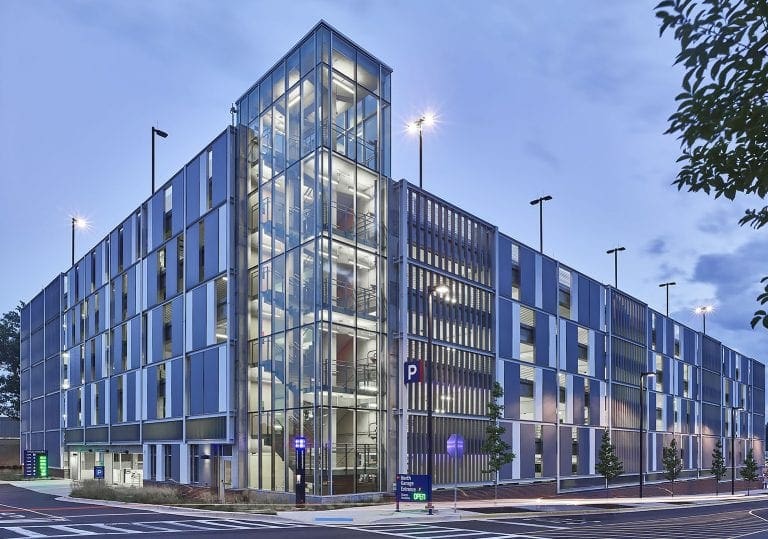
The AIA also compiles a Consensus Construction Forecast based on predictions of seven leading U.S. non-residential construction forecasters. The Consensus Construction Forecast indicates the non-residential building construction industry is expecting continued growth over the next two years, but with potential slowing in 2020. After hitting the 2018 projections for 4% growth in nonresidential construction, the consensus panel projects about the same for 2019 at 4.4% growth, with a drop to 2.4% for 2020. The office sector is predicting strong growth of 5.1% for 2019, but it drops to just 1.2% for 2020. Healthcare and education sector predictions remain strong with healthcare growth of 4% in 2019 and 3.6% in 2020, while education sector growth is predicted to be the highest of all sectors at 5.5% in 2019 and 4.1% in 2020.2
Turner Construction’s Turner Building Cost Index, which tracks construction cost escalation, rose 5.9% during 2018. Its 2018 Fourth Quarter Forecast states that, “The fear of tariffs continues to be the primary cause of uncertainty for contractors nationwide, alongside depleting supplies of skilled labor.”3Additionally, the Turner 2019 First Quarter Forecast indicates a 1.34% cost increase for the quarter and a 5.85% increase over the prior 12 months, stating that, “raw materials have seen some de-escalation since the end of 2018. Fabricated material prices stayed stable in the first quarter of 2019.”4
Engineering News-Record (ENR) recently reported its first quarter 2019 Construction Industry Confidence Index (CICI) remained at 59 points from the previous quarter ending 2018. However, it decreased from 70 or more points on a scale of 100 over where it was for all but one of the previous seven quarters. There is optimism that 2019 will remain strong despite labor shortages, higher labor rates, and tariff uncertainty but, “of the 205 executives of large construction and design firms responding to the survey, many believe the market will begin to decline sometime in 2020.”5
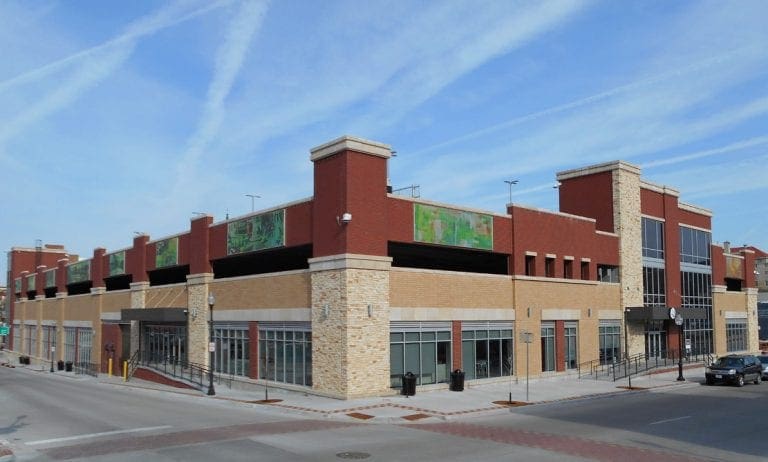
The American Institute of Architects’ (AIA) chief economist Kermit Baker, PhD, stated that, “many indicators of future work at architectural firms remain positive, with both inquiries into new work and the value of new design contracts continuing to grow, although the pace of growth of design contracts has slowed in recent months.” The article also reported that, “the commercial construction sector is not yet overbuilt.”
The sustained growth in architectural firm backlogs, reported by the Architectural Billings Index (ABI), is a positive indicator for near-term growth in parking structure construction. In the absence of any major political or economic event, construction activity is forecasted to grow about 4.4% in 2019 and 2.4% in 2020, including growth in the institutional and commercial sectors that traditionally build parking structures.
There’s an updated version of this study available! Click here to download the 2021 Parking Structure Cost Outlook today!
References
1. The American Institute of Architects (2019, March). “ABI March 2019: Architecture firm billings,” by The American Institute of Architects, from AIA website: https://www.aia.org/pages/ https://www.aia.org/pages/6137577-abi-march-2019-billings-decline-amidst-con.
2. “Though signs point to a slowdown, growth in construction spending should continue through 2020,” by Kermit Baker, PhD, The American Institute of Architects AIArchitect, January 16, 2019.
3. Turner Construction Company. “Turner Building Cost Index – 2018 Fourth Quarter Forecast,” Turner Construction Company website: http://www.turnerconstruction.com/cost-index .
4. Turner Construction Company. “Turner Building Cost Index – 2019 First Quarter Forecast,” Turner Construction Company website: http://www.turnerconstruction.com/cost-index.
5. “Market Still Remains Strong, But Execs Fear 2020 Vision,” by Gary J. Tulacz, Engineering News Record, April 1/8, 2019

WGI is a national design and professional services firm leading in technology-based solutions for the construction of public infrastructure and real estate development. At WGI, we’re providing Tomorrow’s Infrastructure Solutions Today.

Don’t let your next TOD project flop. WGI has the top 10 site-design considerations for building residential housing near transit and the expert team to ensure your TOD project is a success!

WGI welcomes an incredible addition to their team – Ernie Rehm, a distinguished Senior Parking Designer with over two decades of industry expertise.
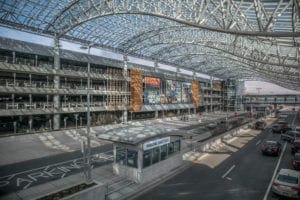
Is your parking system “Smart”? Parking facilities are the first & last impression of customer service. Learn how to maximize efficiency & profitability of your operations when utilizing Smart Parking as you tailor the traveling experience for your customers and make sure that first & last impression is unforgettable.

Melissa’s addition to the team solidifies WGI’s leadership in helping communities harness the benefits of much-needed infrastructure projects throughout the nation.

Welcome back to WGI Unleashed! In this episode, we have the opportunity to chat with Jeremy Rocha, P.E., Senior Project Manager and Parking Solutions Expert.

WGI’s parking experts were thrilled to visit Fort Worth, TX, for this year’s edition of the annual IPMI Parking & Mobility Conference & Expo!
You’ve been searching for a place like WGI. We look forward to meeting you soon.
Sign up to receive emails to hear our latest news and achievements in our monthly newsletter.
Enter your zip code, and we’ll personalize your experience with local projects, office locations, team members, and more.
WGI supports its associates with meaningful opportunities for growth, strong benefits and perks, while we work collaboratively with clients and co-consultants to shape and improve communities.






WGI is a dynamic organization with opportunities nationwide for engineers, land surveyors, landscape architects, environmental scientists, and architects.